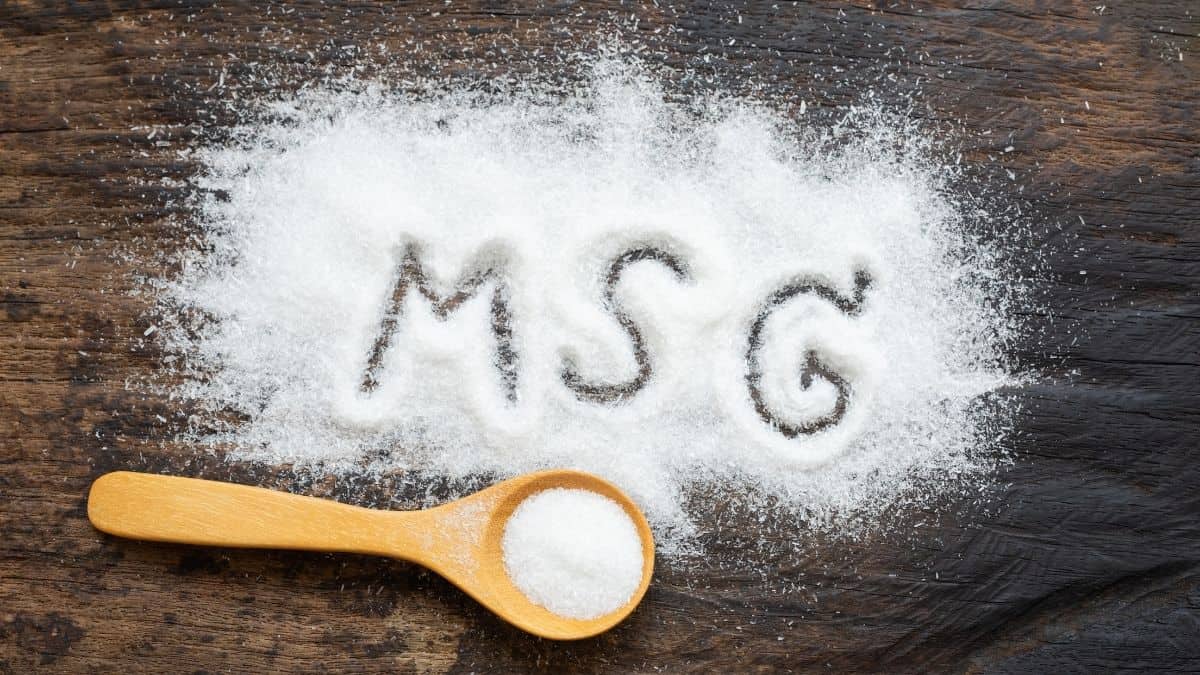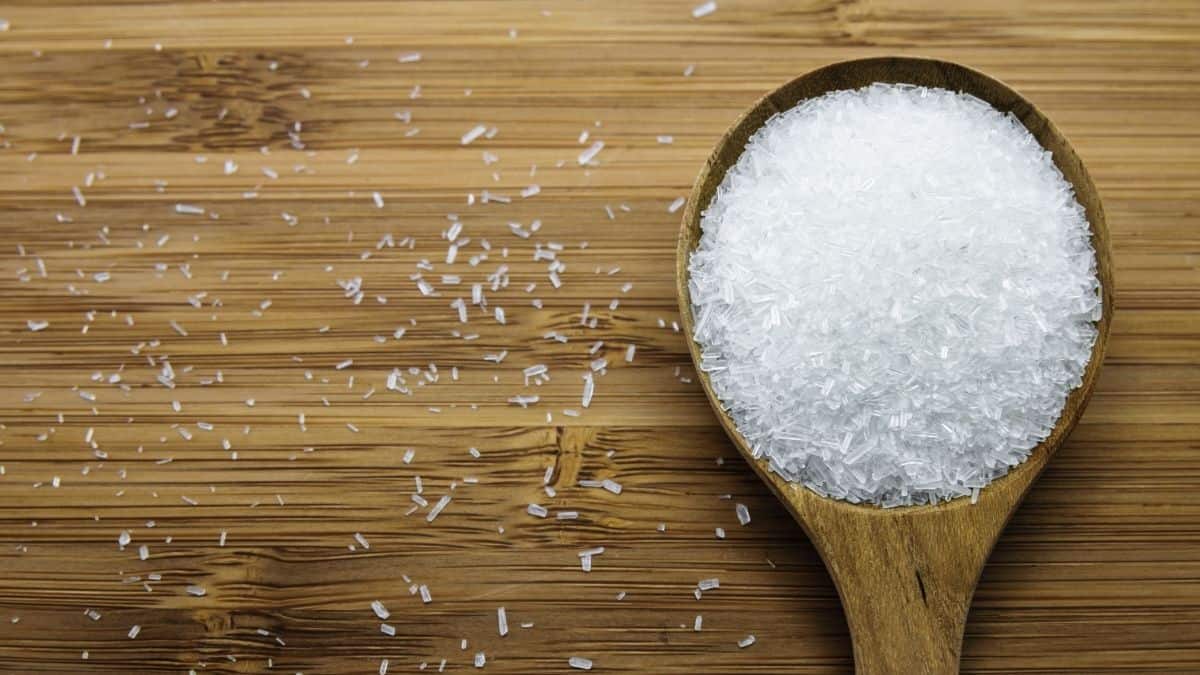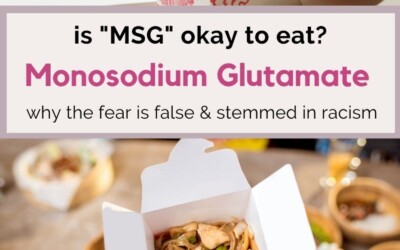DISCLAIMER: This post was developed in a sponsored partnership with Ajinomoto however, as always, all opinions are genuine.
Is MSG really as “bad”as it’s made out to be? Is the whole “Chinese Restaurant Syndrome” thing even real?
In this blog post, we’re going to dive into the facts about this perfectly safe flavor enhancer and dispel the idea that just because you can’t pronounce an ingredient or it has a chemical-sounding name means you should avoid it…. That’s a diet culture lie! After reading this post you’ll be assured that you can go about your grocery shopping and food ordering worry-free!
First, let’s chat about what the heck even IS “MSG”….
What Is It And What Is It Used For?
MSG (or monosodium glutamate) is a seasoning that enhances the flavor of foods by adding umami, a savory taste. Chemically speaking, MSG is made up of sodium, which is in table salt, and glutamate (an amino acid).
Not only is glutamate naturally produced by our bodies, it’s also found in many foods we eat every day. You can find glutamate in foods you probably eat often like tomatoes, mushrooms, aged cheeses and meats. When we eat these foods, the glutamate in them binds to taste receptors on the tongue, creating a delicious savory taste called “umami”. MSG works the same way but without bringing out other flavors, making it the purest form of umami.

Is MSG safe?
Yes! Despite all of the “no MSG” labels you see at grocery stores or on restaurant menus, MSG has undergone extensive scientific research and has been deemed safe to consume by the FDA and many other leading health organizations around the world. Yes. It’s safe to consume even though you might get tongue tied saying its full name.
Some of the confusion around MSG’s safety was fostered by poorly conducted animal studies that injected very high (and unrealistic) doses of MSG into mice. Of course, this method doesn’t accurately represent the way we consume MSG as humans.
But, if you’re still worried about consuming MSG, you might feel better knowing that you’re probably already consuming glutamate regularly An average adult consumes approximately 13 grams of glutamate throughout the entire day from the protein in food (glutamate is an amino acid found in protein!), but intake of added MSG clocks in at an estimated 0.55 grams per day. And fun fact, glutamates have been used as a seasoning for a long time, dating back to ancient Roman times when garum, a fermented fish sauce, was commonly used as a condiment.
Moral of the story? You can continue to enjoy foods with MSG without worry.

The Racist Roots Of MSG Fear
The truth is, MSG fears are not only rooted in flawed science but in racism. So here is the deal.
In 1908, Dr. Kikunae, a Japanese scientist, first discovered “umami” taste and attributed it to glutamate. By 1909, Kikunae had patented the process to make MSG, and the Ajinomoto Group – today’s leading manufacturer of MSG – was founded. MSG was then introduced to the US market in 1917.
It was in 1968 when the fear-mongering around MSG began. A prestigious medical journal published a letter to the editor in which one individual stated they noticed various adverse reactions such as weakness, palpitations and numbness in the arms after eating at a Chinese restaurant. Even though the letter did not attribute his symptoms to any specific ingredient, it gave rise to the term “Chinese Restaurant Syndrome” (or CRS) and the world seemed to latch onto the idea that MSG in Chinese food was to blame. At this time, anti-Asian xenophobia was unfortunately prevalent in American culture and this propagated the outdated and problematic term.
Common Questions About MSG
Does MSG cause you to eat more?
Many people feel that MSG is added to food to get us “addicted” to it. This is not true! Firstly, food is meant to be enjoyed! We want it to taste good! Which explains why so many food manufacturers add MSG – a tasty flavor enhancer – to their products. Secondly, making food more palatable can lead to a more satisfying eating experience, encouraging us to listen to our fullness cues and actually prevent overeating.
You can read more about food obsession and addiction in my blog post here: The Real Reason You’re Obsessed With Food.
Is MSG the same as table salt?
Nope! The chemical makeup of MSG is sodium plus glutamate whereas salt is sodium plus chloride. So while they have some of the same pieces of the puzzle (sodium) they’re not the same. They do not provide the same amounts of sodium nor do they provide the same taste.
Is MSG high in sodium?
In terms of sodium, MSG actually has less than table salt (about 66% less!). If you use MSG as a partial swap for salt, you can lower the sodium content in a dish while also maintaining flavor, so it can be beneficial in that way.
How do you cook with MSG?
Creating a blend of 50/50 salt and MSG is an easy place to start. This blend gives you a 40% reduction in sodium compared to table salt alone and it can be used on grains, vegetables, soups, meat, seafood, etc. Or you can start by adding MSG to taste to recipes – a little goes a long way.
Does MSG cause headaches?
This myth is a super common one so let’s get to the actual facts here! Interestingly enough, based on the scientific evidence we have in relation to MSG and headaches the International Headache Society removed MSG from its list of causative factors for headaches in January of 2018.
And for a little more history on this, in the 1990s reports of headaches and other symptoms purportedly from MSG spurred the FDA and the Federation of American Societies for Experimental Biology (FASEB) to examine the safety of MSG. The results showed that symptoms, like headaches, could only be produced in some sensitive individuals who consumed a bolus of 3 grams or more of MSG without food and symptoms were transient and not serious. Now, it’s important to note that a typical serving of a food with added MSG contains less than 0.5 grams of MSG, so consuming more than 3 grams of MSG without food at one time would be highly unlikely. It would be like eating a spoonful of table salt… probably not something you’re going to actually do!
Is MSG gluten free?
MSG itself is gluten free! However it’s important to check on the other ingredients in a product if you do require a gluten free diet for medical reasons.
Need more info on how to eat intuitively with medically necessary diets? Checkout my blog post on it here: How To Eat Intuitively With Dietary Restrictions.
Is MSG bad for pregnancy?
MSG is deemed safe to consume. However, taste preferences may change during pregnancy and you could be turned off by flavors you normally love, such as umami.

Are There Benefits To Using MSG?
Can help improve overall diet
We’re more likely to eat foods that taste good, right? Well, lucky for us, MSG is a flavor enhancer and by adding it to your foods, (like grains, roasted vegetables, soups, etc) you’re going to be more likely to consume those foods that provide important nutrients to our bodies.
Like I’ve mentioned before in this post, food is meant to be enjoyed! Food is more than just nutrients. It should be emotional! When we eat more enjoyable foods more often, we’re less likely to feel “out of control” around them when we do get our hands on them. This is a big reason why binge eating occurs.
This increase in enjoyment can also help increase satisfaction with eating. When we switch ourselves off of autopilot mode, we are more likely to listen to our hunger and fullness cues. A great way to bring yourself back to the present moment? Focusing on the taste of your food! One of my best, simple mindful eating tips is to simply ask yourself “how does the food taste?” If our food is tasty, this question is easy to answer! This awareness will bring you back to the present moment and allow you to check in with your fullness and satisfaction levels.
Looking for more ways to improve your nutrient intake? Be sure to check out my blog post about the concept of “gentle nutrition”: Getting Started With Gentle Nutrition.
Can reduce sodium intake
See my notes above! But, the reality is 90% of people consume too much sodium and MSG is one tool that can help you cut back on your intake, which is particularly important if you have conditions like heart disease or high blood pressure.

Final Verdict On MSG
Despite much of the negativity we see associated with MSG, the ingredient is safe to consume and offers real taste and nutrition benefits (like sodium reduction.) Many of the misperceptions around this ingredient are rooted in racism, misinformation, and flawed studies.
Instead of avoiding MSG, get to know the facts about the foods you eat and tune into how different foods make you feel. If a food doesn’t make you feel great, get curious! Start experimenting and finding out why that might be.
Not sure how to know what foods make you feel your best? Try using a food and mood journal! I have a whole blog post explaining how to use it here: Intuitive Eating Food And Mood Journal How-To.
Lastly, having variety in the foods we eat is super important, and tools like MSG can help make nutrient dense foods more tasty and enjoyable which can actually help improve the nutrient quality of your diet.
But before you say “no” to MSG,” how about we first get to KNOW MSG? Checkout KnowMSG.com for more info and facts!
XOXO
-Colleen



Leave a Reply